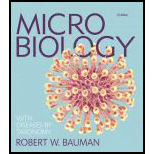
Microbiology with Diseases by Taxonomy (5th Edition)
5th Edition
ISBN: 9780134019192
Author: Robert W. Bauman Ph.D.
Publisher: PEARSON
expand_more
expand_more
format_list_bulleted
Question
Chapter 4, Problem 4TMW
Summary Introduction
To explain:
The reason as to why Linnaeus did not classify the viruses.
Introduction:
Carolus Linnaeus was a Swedish botanist and he was the first scientist to start the naming system of living organisms. In 1953, Linnaeus published his first book “Species Plantarum”. He classified the living organisms on the basis of characteristics they share with resembling organisms.
Expert Solution & Answer
Want to see the full answer?
Check out a sample textbook solution
Students have asked these similar questions
What is the structure and function of Eukaryotic cells, including their organelles? How are Eukaryotic cells different than Prokaryotic cells, in terms of evolution which form of the cell might have came first? How do Eukaryotic cells become malignant (cancerous)?
What are the roles of DNA and proteins inside of the cell? What are the building blocks or molecular components of the DNA and proteins? How are proteins produced within the cell? What connection is there between DNA, proteins, and the cell cycle? What is the relationship between DNA, proteins, and Cancer?
Why cells go through various types of cell division and how eukaryotic cells control cell growth through the cell cycle control system?
Chapter 4 Solutions
Microbiology with Diseases by Taxonomy (5th Edition)
Ch. 4 - Prob. 1MCCh. 4 - A nanometer is ________ than a micrometer. a. 10...Ch. 4 - Prob. 3MCCh. 4 - Curved glass lenses _________ light. a. refract b....Ch. 4 - Prob. 5MCCh. 4 - Prob. 6MCCh. 4 - Which of the following types of microscopes...Ch. 4 - Prob. 8MCCh. 4 - Prob. 9MCCh. 4 - Prob. 10MC
Ch. 4 - If an objective magnifies 40 and each binocular...Ch. 4 - The type of fixation developed by Koch for...Ch. 4 - Immersion oil ________ (increases/decreases) the...Ch. 4 - Prob. 4FIBCh. 4 - Prob. 5FIBCh. 4 - Prob. 1VICh. 4 - Label the microscope.Ch. 4 - Prob. 1SACh. 4 - Critique the following definition of magnification...Ch. 4 - Prob. 3SACh. 4 - Prob. 4SACh. 4 - Prob. 5SACh. 4 - Give three characteristics of a specific epithet.Ch. 4 - Prob. 7SACh. 4 - Prob. 8SACh. 4 - Prob. 1CTCh. 4 - Prob. 2CTCh. 4 - Prob. 3CTCh. 4 - Prob. 4CTCh. 4 - Prob. 5CTCh. 4 - In what ways are the Gram stain and the acid-fast...Ch. 4 - Microbiologists have announced the discovery of...Ch. 4 - Why is the genus name Coccus placed within...Ch. 4 - A clinician obtains a specimen of urine from a...Ch. 4 - Using the following terms, fill in the following...Ch. 4 - Prob. 1TMWCh. 4 - Prob. 2TMWCh. 4 - Prob. 3TMWCh. 4 - Prob. 4TMWCh. 4 - Prob. 1EDCS
Knowledge Booster
Learn more about
Need a deep-dive on the concept behind this application? Look no further. Learn more about this topic, biology and related others by exploring similar questions and additional content below.Similar questions
- In one paragraph show how atoms and they're structure are related to the structure of dna and proteins. Talk about what atoms are. what they're made of, why chemical bonding is important to DNA?arrow_forwardWhat are the structure and properties of atoms and chemical bonds (especially how they relate to DNA and proteins).arrow_forwardThe Sentinel Cell: Nature’s Answer to Cancer?arrow_forward
- Molecular Biology Question You are working to characterize a novel protein in mice. Analysis shows that high levels of the primary transcript that codes for this protein are found in tissue from the brain, muscle, liver, and pancreas. However, an antibody that recognizes the C-terminal portion of the protein indicates that the protein is present in brain, muscle, and liver, but not in the pancreas. What is the most likely explanation for this result?arrow_forwardMolecular Biology Explain/discuss how “slow stop” and “quick/fast stop” mutants wereused to identify different protein involved in DNA replication in E. coli.arrow_forwardMolecular Biology Question A gene that codes for a protein was removed from a eukaryotic cell and inserted into a prokaryotic cell. Although the gene was successfully transcribed and translated, it produced a different protein than it produced in the eukaryotic cell. What is the most likely explanation?arrow_forward
- Molecular Biology LIST three characteristics of origins of replicationarrow_forwardMolecular Biology Question Please help. Thank you For E coli DNA polymerase III, give the structure and function of the b-clamp sub-complex. Describe how the structure of this sub-complex is important for it’s function.arrow_forwardMolecular Biology LIST three characteristics of DNA Polymerasesarrow_forward
arrow_back_ios
SEE MORE QUESTIONS
arrow_forward_ios
Recommended textbooks for you
 Principles Of Radiographic Imaging: An Art And A ...Health & NutritionISBN:9781337711067Author:Richard R. Carlton, Arlene M. Adler, Vesna BalacPublisher:Cengage LearningSurgical Tech For Surgical Tech Pos CareHealth & NutritionISBN:9781337648868Author:AssociationPublisher:Cengage
Principles Of Radiographic Imaging: An Art And A ...Health & NutritionISBN:9781337711067Author:Richard R. Carlton, Arlene M. Adler, Vesna BalacPublisher:Cengage LearningSurgical Tech For Surgical Tech Pos CareHealth & NutritionISBN:9781337648868Author:AssociationPublisher:Cengage Comprehensive Medical Assisting: Administrative a...NursingISBN:9781305964792Author:Wilburta Q. Lindh, Carol D. Tamparo, Barbara M. Dahl, Julie Morris, Cindy CorreaPublisher:Cengage Learning
Comprehensive Medical Assisting: Administrative a...NursingISBN:9781305964792Author:Wilburta Q. Lindh, Carol D. Tamparo, Barbara M. Dahl, Julie Morris, Cindy CorreaPublisher:Cengage Learning

Principles Of Radiographic Imaging: An Art And A ...
Health & Nutrition
ISBN:9781337711067
Author:Richard R. Carlton, Arlene M. Adler, Vesna Balac
Publisher:Cengage Learning


Surgical Tech For Surgical Tech Pos Care
Health & Nutrition
ISBN:9781337648868
Author:Association
Publisher:Cengage


Comprehensive Medical Assisting: Administrative a...
Nursing
ISBN:9781305964792
Author:Wilburta Q. Lindh, Carol D. Tamparo, Barbara M. Dahl, Julie Morris, Cindy Correa
Publisher:Cengage Learning

Biochemical Tests-Part 1; Author: Southern Stacker;https://www.youtube.com/watch?v=a-i9vANfQWQ;License: Standard Youtube License